Chintamani Hasabnis, a consummate portrait artist from Pune, is perhaps the only person in India
who has accomplished the unique and seemingly impossible task of making the blind not only “see”
but also engage them in aesthetic appreciation of his paintings. What is more, he has done this while
at the same time keeping intact such appreciation of the same painting by the sighted. He has taken
immense pains, through 12 years of trial, error, and a wide range of studies and experimentation, to
develop this composite style of painting technique which is earning him rich dividends in terms of
personal fulfilment, through this unique ‘vision donation’ to those deprived of it, says Shubha
Khandekar.
“Where is the long-off fielder?” she whispered, moving her fingertips slowly, carefully all over the painting of a cricket match, after successfully identifying the bowler, batsmen, wicket keeper and several other players on the field. Dozens of spectators around her gaped in silence.
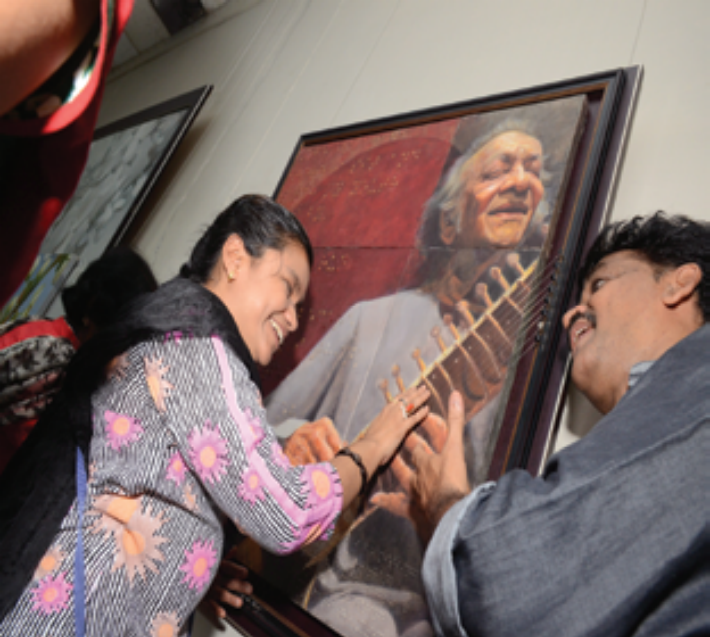
Mani was stumped too but he stepped up nevertheless and explained to her the reason for the absence of such a fielder from the painting. She nodded but said nothing. Before leaving, she told Mani, “Your painting made me feel as if I was a spectator watching a live cricket match being played in the ground in front of me.” And then added assertively, “Still, I would have liked a long-off fielder there.”
She was Komal Gavas, 20, congenitally, totally blind. She had come to see an exhibition of Mani’s paintings at Fergusson College in Pune, along with her classmates — also blind.
Chintamani Hasabnis — Mani for family and friends – 57, is likely the only person in India who is fired with the idea of creating paintings that the blind can see. Or rather, paintings that the blind too can see, for, making the blind “see” a painting is too restrictive an aspiration for him. “My goal is to create paintings that the blind and the sighted can together see and help each other in appreciating their aesthetic merit,” he says. An accomplished portrait artist, Hasabnis is a recipient of this year’s prestigious Ravi Paranjape Gunijan Award, which he shared with Charuhas Pandit, whose child cartoon character Chintoo is now a household name in Maharashtra. The annual award has been instituted by the Ravi Paranjape Foundation to recognise outstanding and sustained achievement in fine arts.
Hasabnis had always wanted to harness his artistic prowess to create not only something unique, but also something socially relevant and meaningful. After seeing blind individuals going about in life with remarkable confidence, he began to wonder whether aesthetic appreciation of painting, an exclusively visual two dimensional art, could be brought within their reach. That led him to the realisation that even the sighted cannot be engaged in an aesthetic appreciation of painting because they do not have any artistic perspective, they cannot “see” a painting the way it deserves to be seen. Here was born the path breaking idea of addressing both these categories of viewers together, which also met both of Hasabnis’ preconditions for carrying out further work in his chosen field.
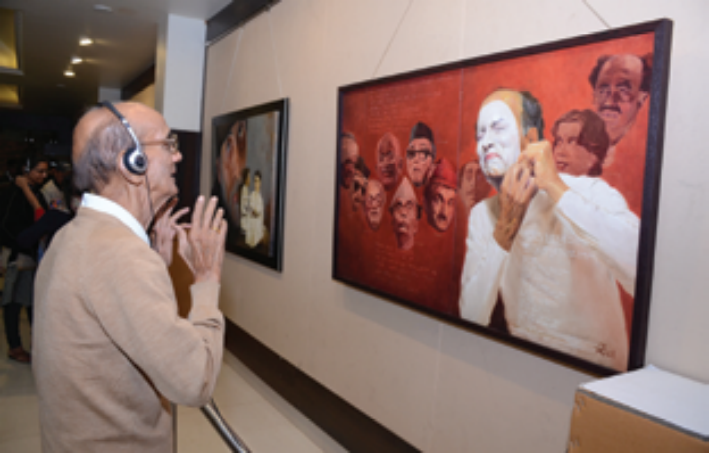
“My attempts to create a composite form of painting, which began as a seemingly impossible challenge of making the blind “see”, transformed my life and that of my family too, by 360 degrees. As a means to dissolve the barrier between the blind and the sighted, it has been as liberating to my blind friends as it has been to me and they are now integral to my mission of designing a profound, wholesome and fulfilling aesthetic experience for both the blind and the sighted in a collaborative and symbiotic initiative,” he says.
Creating such a composite medium was indeed a multidimensional challenge, and started with acquiring a primary understanding of the physiological aspect of “seeing” and of how exactly a visually impaired person is biologically equipped for compensating this lacuna. He learned that the visual cortex located in the occipital lobe of the brain gets activated even when the source of the stimulation is a sense organ other than the eye, which in turn triggers its interpretation by the brain. This prompted him to wonder if this complex process could be harnessed to make the blind “see” exactly, or almost so, as the sighted do. If yes, then it should be possible to further develop this ability into aesthetic appreciation of a painting. This was an epiphany!
Hasabnis began to spend hours outside schools and hostels for the blind, silently observing them conversing with each other and with the sighted. He made a detailed study of their body language, their interests, which were topped by cricket, their facial expressions, their perceptions and responses, their concept of “seeing” . . .
He learnt English and Marathi braille, to read as well as to write. He moved around blindfolded in his house to experience the challenges that the blind constantly face with architectural hurdles and furniture. As mundane activities turned into great challenges, his frustration fuelled his urge to meet them headlong.
Observation and experience told Hasabnis that the blind cannot visualise the size of huge objects such as trees, trains or buses. Nor can they understand that objects at a distance appear small. They can only get an approximate idea of a shape but not its details. Flat, 2-dimensional art is inaccessible to the blind, but texture could be included to be perceptible to both blind and sighted persons.
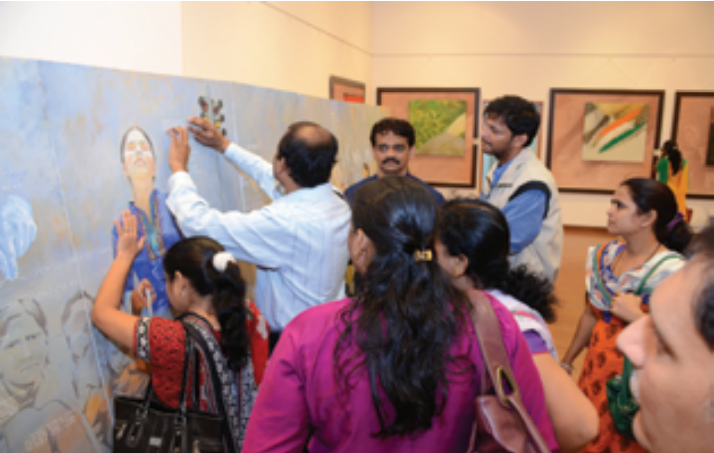
But just learning was not enough. Hasabnis strove to unlearn the skills of sighted people, to erase memories of a seeable world, which awakened him to the comparative strengths and weaknesses of the blind and the sighted. Armed with this consciousness, he went ahead to identify six steps by which a person, whether blind or sighted, arrives at aesthetic appreciation of an art object. He became obsessed with the idea of empowering the blind with the tools required for aesthetic appreciation of paintings, seeing his work as his own contribution towards a more humane, egalitarian and non-discriminatory world.
“Painting is inherently an abstract art form, a medium which conveys the artist’s feelings to the viewer. An artist uses his own language, his own grammar and his own tools to express himself on canvas. Each viewer in his own way and by his own effort decodes all these components and tries to appreciate them. This is an intricate process and a positive outcome of it depends as much on the intellectual capability and skill of the artist as it does on the receptivity of the viewer. I have tried to understand this intricate process in every possible detail in order to arrive at my goal,” he reveals.
The unique tapestry of Hasabnis’ endeavour is woven with two strains of his perception. One, that the sighted must be stimulated into “seeing” a painting with a higher level of mindfulness and two, if the blind are given appropriate tools, they could transcend the visible aspects of the same painting and explore and grasp the deeper meanings and emotions that the artist has hoped to convey.
Hasabnis crafted his strategy to not only address both his target viewers together, but to also develop an interdependence between them for a mutually rewarding outcome, by harnessing the strengths of one to cover the weaknesses of the other. He decided that tactile and auditory components must be introduced into a painting and that the blind must be allowed to touch the paintings to diminish the distance between the painting and the blind viewer and foster a dialogue. He made use of raised lines, textures, and actual objects, such as the strings of a sitar, a cricket ball and a bicycle bell in the paintings. He devised an emotional decoder by arranging text matter consisting of supportive analysis and even poetry, in braille in certain specific patterns on the canvas, which would add an extra dimension to the painting and would appeal to the sighted too. He also made use of audio clips for those blind who could not read braille.
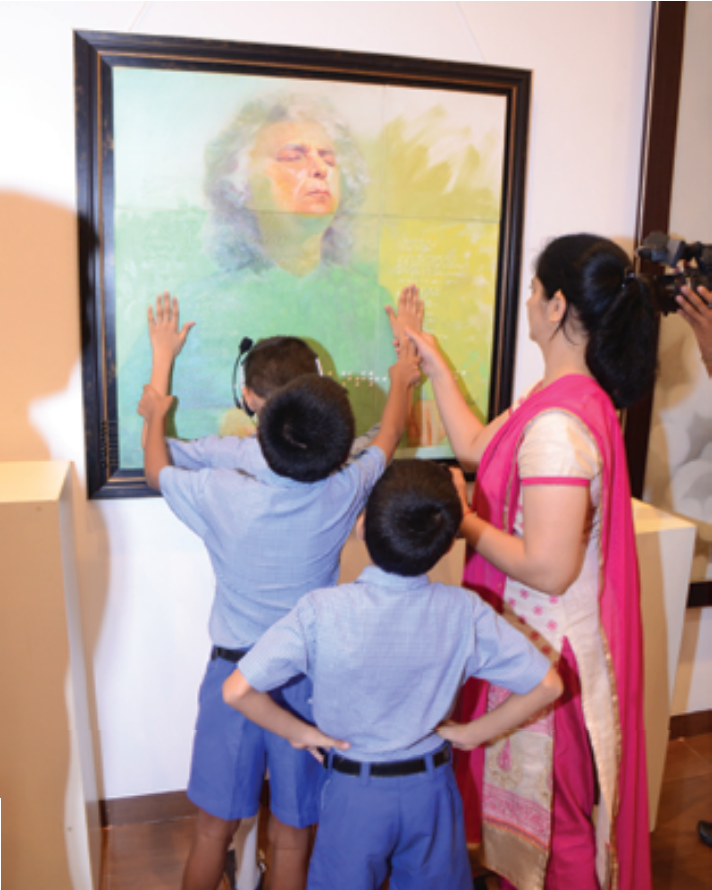
After being bitten by the bug for ‘painting for the blind’ twelve years ago, Hasabnis burnt the midnight oil for three years, frantically wielding his brush to create twenty five large, composite paintings which were displayed at a special exhibition, his first such with the visually impaired as his targeted viewers, in 2015 at the Nehru Centre, Mumbai. Significantly titled, “Closed Eyes and Open Minds”, this unique show was visited by over 600 blind people from different parts of Maharashtra, as also by about a 1000 sighted individuals simultaneously. The outcome was truly astonishing.
No less than 355 sighted visitors filled up the form for eye donation, and 17 did so for organ and body donation.
Within three months another exhibition was put up in Pune which was keenly visited by 1300 odd blind people. This snowballed over the next ten years into a series of 14 such exhibitions that progressively brought more and more insights for Hasabnis to fine tune his craft. But more than that it brought him the satisfaction of the endorsement of his bold, pioneering initiative – intuitive, well-grounded and purposeful.
The moment of triumph came when Hasabnis saw student after blind student of Fergusson College explaining his paintings exhibited there, to the sighted people, who clearly looked gobsmacked at their own visual inadequacies! The blind had captured accurately and were articulating clearly the emotions that he, as the creator of the art form, had hoped to convey to the sighted. It was indeed a fascinating, joyous and deeply satisfying finale to the artist’s labour of love that had been his obsession for close to twelve years.
Not satisfied with the blind individuals’ testimony that they could “see” his paintings, Hasabnis organised a survey wherein a common questionnaire was given to the blind and the sighted visitors. The responses were indeed revealing and thought provoking.
When asked, “What thought came into your mind after seeing this painting?” a sighted person replied, “Had I seen this painting unaided by a blind person, the finer nuances placed there in braille would have escaped me and I would not have been able to appreciate the painting. In fact, as I would never have given a thought to these points, I was ill-equipped to undertake an aesthetic appreciation of the painting.”
A blind visitor’s response to the same question was, “I felt as if I was a viewer on the cricket ground watching the match live. Such paintings are indeed revolutionary.”
When asked which part of the painting they found difficult to understand, the blind person’s response was, “The batsman has not been shown, hence I could not understand the position of the pitch. Also, I found all the fielders, except long-off.”
The sighted person confessed that he could not grasp the real meaning of the painting.
But the most astonishing insight emerged when the blind as well as the sighted were asked to list all the objects and their locations shown in the painting. To this, 73% sighted people replied, “Don’t know,” whereas 59% of the blind persons were able to accurately name all the objects and their placement on the canvas!
With his tried and tested approach of “Closed Eyes and Open Minds,” Hasabnis has demonstrated that the visually impaired can successfully rise in the role of a friend-philosopher-teacher-guide to the sighted, in accessing and sharing the deeper meaning of art, specifically painting, which had so far eluded the latter’s visual apparatus. He is often invited to exhibit all across the state and beyond, but regrets that it is not always possible for the visually impaired to travel to visit the exhibition due to distances and expense. He is now working on a book of paintings for them and on building an ‘art understanding kit’ using braille with audio-visual tools.
“This work, as a way forward towards a more responsible, humanitarian, egalitarian and discrimination-free world is, I believe, the most urgent need today and will forever remain a source of immense joy and gratification for me,” he smiles.
Mani used to fight shy of autographing his paintings, insisting that the work itself should be his signature. That has come true quite literally. If you see the blind and the sighted flocked together around a painting in its appreciation, you can rest assured it is the work of Chintamani Hasabnis.
More power to your brush, and to your braille slate too, Mani!
PS: He started signing his paintings on the insistence of renowned tabla player Ustad Zakir Hussain, who commissioned Hasabnis to make a portrait of his illustrious father Ustad Alla Rakha.

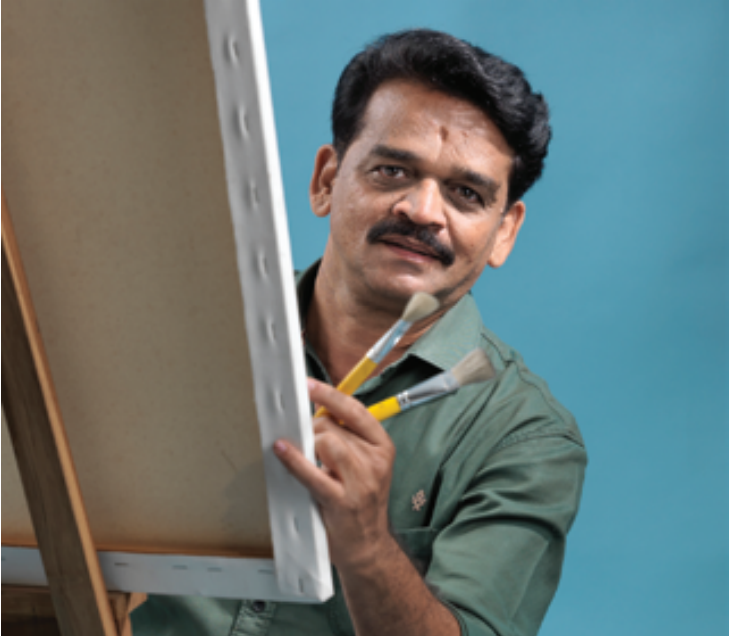
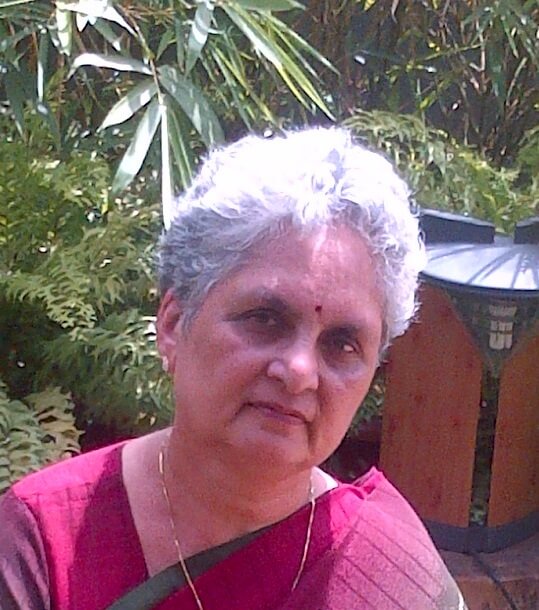 Ms. Shubha Khandekar is the author-illustrator of ArchaeoGiri: The Bridge between the Archaeologist and the Common Man, an infotainment book on Indian history and archaeology.
Ms. Shubha Khandekar is the author-illustrator of ArchaeoGiri: The Bridge between the Archaeologist and the Common Man, an infotainment book on Indian history and archaeology.